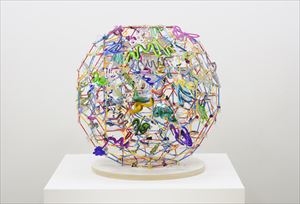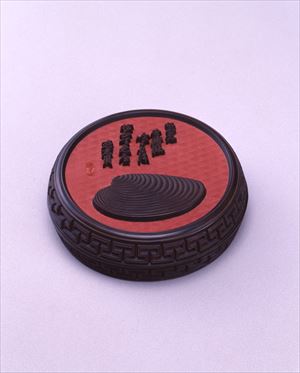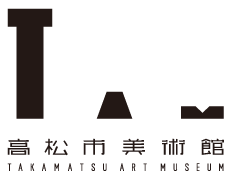PERMANENT Collection 3rd term 2018
PERMANENT
PERMANENT Collection 3rd term 2018
Japanese Contenmporary Art since the 1990s
The Takamatsu Art Museum special exhibition entitled “Starting Points: Japanese Art of the 80s” (November 3–December 16, 2018) reinterprets currently evolving artistic trends by seeking their origins in the 1980s in a novel way.
In relation to it, in permanent exhibition hall No.1, 28 works by 21 artists take an overview of contemporary Japanese art currents from the 1990s and the first decade of the 21st century and investigate how tends originating in the 1980s were continued (or in some cases rejected) and how they developed thereafter.
For example, the same emotionality observed in the refined expressions of the “everyday”—important for the individual artist—of Katsuhiko Hibino and Tomoko Sugiyama is to be seen in the paintings of Yoshitomo Nara and Hiroshi Sugito from the 1990s. In the three-dimensional field in the 1980s, Kodai Nakahara chose sizes and materials free of stereotypical considerations. At the same time, Hajime Imamura produced works with a sense of floating by using lightweight materials. In these ways, they overturned conventional images of sculpture. Since the 1990s, Motohiko Odani, Kohei Nawa, and Kengo Kito have variously experimented with this untrammeled approach to three-dimensional expression.
This exhibition on artistic starting points of the 1980s provides a splendid opportunity to enjoy numerous examples of the diversity of modern Japanese art in the 1990s and beyond.

Teppei Kaneuji《Day Tripper (Sculpture of Photogragph of paint)》2010
The History of Sanuki Lacquer Art
The art of Kagawa Lacquerware (Shitsugei) was established toward the end of the Edo Period by Master Craftsman, Zokoku Tamakaji (1806-1869). Around that time,arts and crafts were advanced to a higher level in Japan. The sparkling Makie, created by sprinkling gold and/or si1ver powder over painted patterns in lacquer, was the main lacquer decoration technique. Upon careful examination of lacquerware from China and the Rantai Shikki, where the lacquer is applied over pots and jugs made of bamboo skins, from Southeast Asia, Master Zokoku locally developed three distinctive techniques of lacquerware; Kinma, Choshitsu, and Zonsei.
After Zokoku’s death, his brother, Kokusai Fujikawa tried to industrialize lacquerware by producing items for daily use using Kinma and Zonsei techniques only to be unsuccessful. By the late Meiji Period, Zonsei, once synonymous with Sanuki Lacquerware, vanished.(Sanuki is the old name for this region, roughly today’s Kagawa Prefecture.) Instead, Sanuki Relief, where a carved surface is coated with colored lacquer, became mainstream. As a result, masters in engraving techniques of lacquerware, such as Keido Ishii and Kamada Kado, emerged from Hyakkaen, a store that handled Sanuki Relief, and its surrounding neighborhood.
During the early Taisho Period(1912-1926), Joshin Isoi revitalized the once declining art of Sanuki Lacquerware by successfully inventing a new method of dot engraving, Tenbori-Kinma, which creates depth and three-dimensional effects. Also, Kodo Otomaru, Keido’s apprentice, crafted superior Choshitsu by applying multicolored lacquer.
The Safeguarding the Important Intangible Cultural Heritage of Japan Act was established in 1955, and Kodo Otomaru was recognized for his Choshitsu technique. A year later, Joshin Isoi was certified for using Kinma techniques followed by Masami Isoi in 1985, Hitoshi Ota in1994, and Yoshito Yamashita in 2013. In addition, Bokkei Akashi and Tadao Onishi created painterly works for the Japan Fine Arts Exhibition, Nitten, which opened up a whole new world of interior déor.
A total of 35 works by 26 artists ranging from the founder of the style Zokoku Tamakaji (1806–69) to people active today—some of them designated so-called living national treasures—has been selected from the museum’s collection to illustrate the genealogy of Sanuki lacquer work. (Some displays will change during the run of the exhibition.)

Zokoku Tamakaji《Incense case,'Matsugaura',tsuikoku in sanuki relief》1851
Information
Period:
September 29(Sat)-December 24(Mon),2018
Venue:
Permanent Collection Gallery
Closed:
Monday(the following weekday if Monday is a holiday)
Hours:
Monday - Saturday & Holidays: 9:30 - 17:00 (Entry until 16:30)
*Until 19:00 during special exhibitions from Tuesday through Saturday and national holidays *Last entry is 30 minutes prior to closing.
Organized by:
TAKAMATSU ART MUSEUM
Admission:
【General 】200yen(160yen)
【University students】150yen (120yen)
【High school age or younger/ Seniors 65+】Admission free
※Advance Purchase and Groups of 20 or More Get Discounts (pricing in parenthesis)
※Free admission for those with a physical disability certificate, rehabilitation certificate, or mental disability certificate.
Telephone Inquiry
Takamatsu Art Museum
TEL +81-87-823-1711






